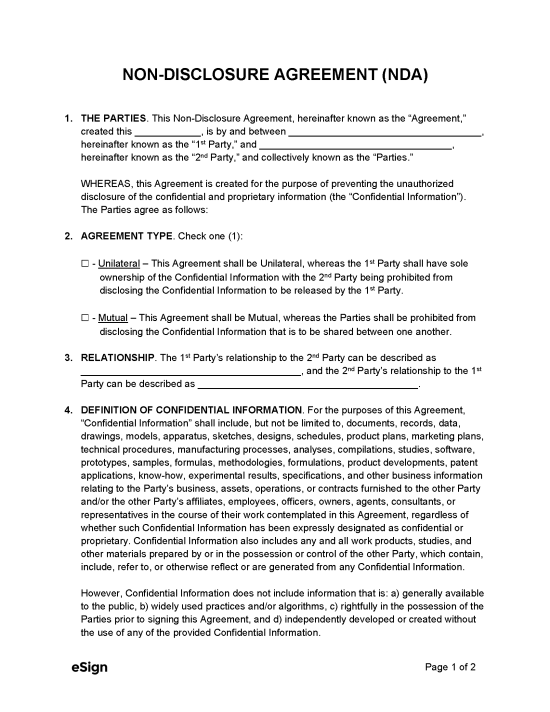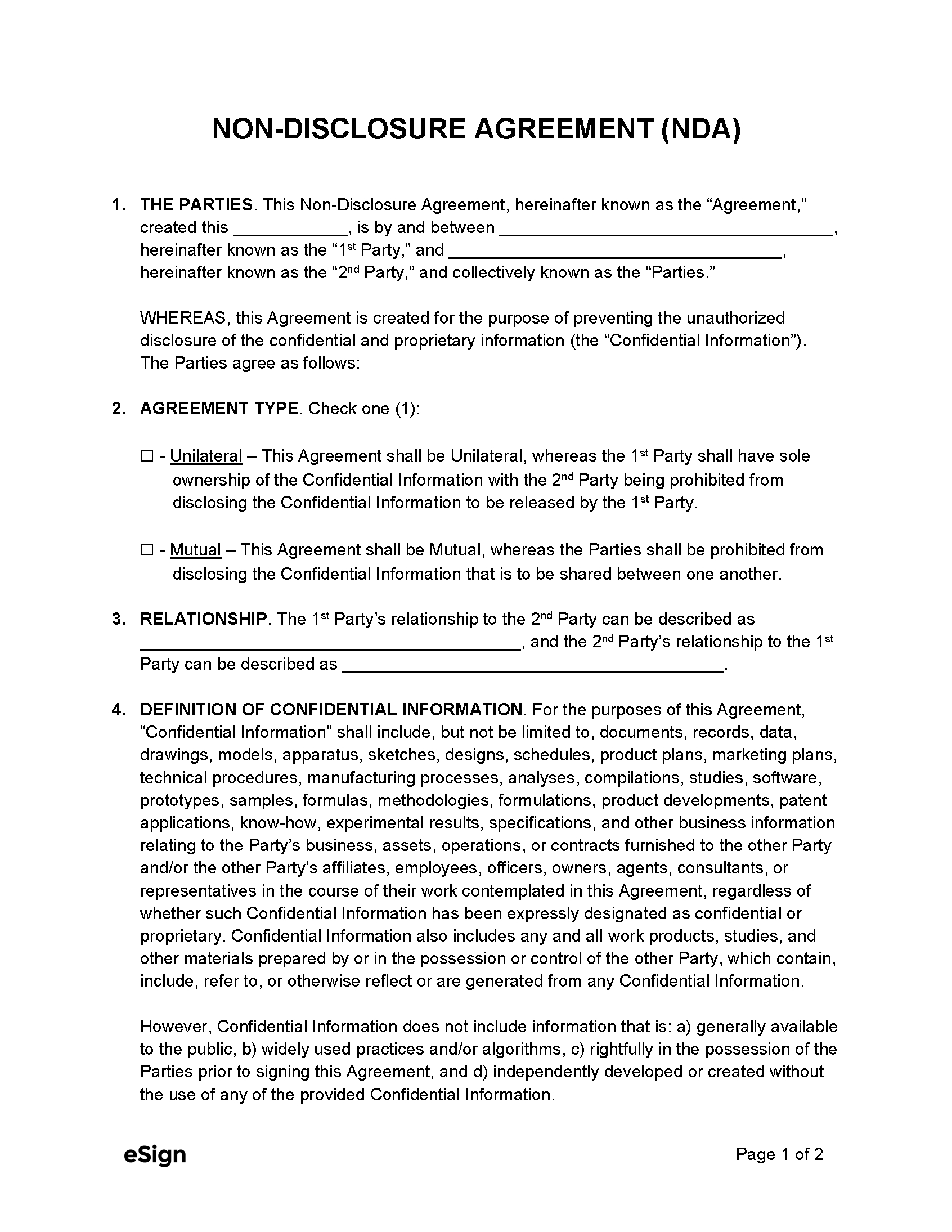What’s Included
The identification of the parties involved must be included. Often the relationship of the parties to each other will be provided as well.
The form must also indicate whether it is “mutual” (both parties must protect confidential information) or “unilateral” (only one party must protect confidential information).
Definition of Confidential Information
An NDA must include language that relays what constitutes confidential information (materials, discussions, designs, data) as well as what is not included in the definition (public knowledge, independently developed information).
Obligations
This section of the NDA reveals the parties’ duty to keep the information confidential, including how protected information should be handled, when it can be disclosed, and when materials must be returned to the owner upon request.
Enforcement
NDAs must define the legal remedies and damages that a party can pursue if the other party fails to uphold their obligations.
Sample
Download: PDF, Word (.docx), OpenDocument
NON-DISCLOSURE AGREEMENT (NDA)
1. THE PARTIES. This Non-Disclosure Agreement, hereinafter known as the “Agreement,” is created this [MM/DD/YYYY], by and between [1ST PARTY NAME], hereinafter known as “1st Party,” and [2ND PARTY NAME], hereinafter known as “2nd Party,” and collectively known as the “Parties.”
WHEREAS, this Agreement is created for the purpose of preventing the unauthorized disclosure of confidential and proprietary information (the “Confidential Information”). The Parties agree as follows:
2. AGREEMENT TYPE. Check one (1):
☐ – Unilateral – This Agreement shall be Unilateral, whereas the 1st Party shall have sole ownership of the Confidential Information, with the 2nd Party being prohibited from disclosing the Confidential Information to be released by the 1st Party.
☐ – Mutual – This Agreement shall be Mutual, whereas the Parties shall be prohibited from disclosing the Confidential Information that is to be shared between one another.
3. DEFINITION OF CONFIDENTIAL INFORMATION. The Confidential Information of a Party may include, but not be limited to that Party’s: (1) plans, methods, and practices; (2) personnel, clients, and suppliers; (3) inventions, methods, products, patent applications, and other proprietary rights; or (4) specifications, drawings, models, samples, tools, technical information, or other related information. However, Confidential Information does not include information that is: a) generally available to the public, b) widely used practices and/or algorithms, c) rightfully in the possession of the Parties prior to signing this Agreement, and d) independently developed or created without the use of any of the provided Confidential Information.
4. OBLIGATIONS. The obligations of the Parties shall be to hold and maintain the Confidential Information in the strictest of confidence at all times and to their agents, employees, representatives, affiliates, and any other individual or entity that is on a “need to know” basis. Neither Party shall, without the other Party’s written approval, publish, copy, or use the Confidential Information for their sole benefit. If requested, either Party shall be bound to return any and all materials within seven (7) days to the Requesting Party. This Section shall not apply to the 1st Party if this Agreement is Unilateral.
5. TIME FRAME. The bounded Party’s(ies’) duty to hold the Confidential Information in confidence shall remain in effect until such information no longer qualifies as a trade secret or written notice is given releasing such Party from this Agreement.
6. SEVERABILITY. If a court finds that any provision of this Agreement is invalid or unenforceable, the remainder of this Agreement shall be interpreted so as best to affect the intent of the Parties.
7. ENFORCEMENT. The Parties acknowledge and agree that due to the unique and sensitive nature of the Confidential Information, any breach of this Agreement would cause irreparable harm for which damages and/or equitable relief may be sought. The harmed Party in this Agreement shall be entitled to all remedies available at law.
8. GOVERNING LAW. This Agreement shall be governed under the laws in the State of [STATE NAME].
9. SIGNATURES. In witness whereof, the parties hereto have executed this Agreement as of the date written below.
1st Party Signature: _____________________ Date: [MM/DD/YYYY]
Printed Name: [1ST PARTY NAME]
2nd Party Signature: _____________________ Date: [MM/DD/YYYY]
Printed Name: [2ND PARTY NAME]

